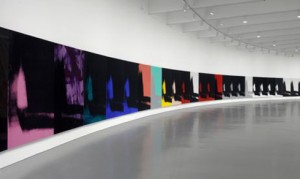 Only a couple of weeks are left in the Warhol stand in Washington. In addition to “Warhol: Headlines” show at the National Gallery, closing Jan. 2, there is an epic presentation of the epic “Warhol: Shadows” at the Hirshhorn, that I just got to this week.
Only a couple of weeks are left in the Warhol stand in Washington. In addition to “Warhol: Headlines” show at the National Gallery, closing Jan. 2, there is an epic presentation of the epic “Warhol: Shadows” at the Hirshhorn, that I just got to this week.
The man who made pop from mass produced images came his closest to pure abstraction through his series of 102 oversized images of a shadow in the corner of his studio.
Silkscreened and turned to broad swatches of color in the manner of his blown up Polaroid portraits, they become monumental in the presentation at the Hirshhorn, covering what must be 70 percent of Gordon Bunshaft’s round second floor gallery. First made in 1978, they have only rarely hung together until Dia in New York brought them together in 1998. But that was only on flat walls in squared off (but huge) gallery.
At the Hirshhorn, the dramatic presentation engulfs the viewer, like a 19th century diorama or even Matisse’s water lilies.
Standing the middle of the works, hung edge to edge, one can’t see its beginning or end, as it curves away, like a horizon at the end of the ocean, away from sight. Warhol once called it “one painting.. with parts” and like examining a huge piece of celluloid film, in which each frame is subtly different, viewers have to walk its 450 linear feet to see it all.
And walking past it, “Shadows” is no mass production. Each frame of the shadow is different; angles are shaved or shifted slightly in the bones of the silkscreen, its resulting colors sometimes mopped on so thickly as to be painterly. The combinations of colors are worth contemplation as well yellow on black, white on aqua, or white and black in the tradition of the bold strokes of abstract expressionist kings from Franz Kline to Robert Motherwell.
It’s surprising how effective it is, considering how little he apparently thought of it, when he made it relatively late in his career, in 1978 at age 50. “Someone asked if I thought they were art, and I said no,” he wrote in New York magazine after hanging an 83-panel version of the show. “The opening party had disco. I guess that makes them disco decor.”
At any rate, he hung the 76 by 52-inch panels at eye level a foot above the floor. “Any lower and people would kick them, especially at a party,” Warhol said.
There’s no kicking them now. The vibrancy of his design and boldness of his color couldn’t be denied.
“Andy Warhol: Shadows” continues at the Hirshhorn through Jan. 15.